ECU Lancia Thema 2013 Owner handbook (in English)
[x] Cancel search | Manufacturer: LANCIA, Model Year: 2013, Model line: Thema, Model: Lancia Thema 2013Pages: 336, PDF Size: 3.87 MB
Page 40 of 336

Service Active Hood System
If the ORC has deployed the Active
Hood, or if it detects a malfunction in
any part of the system, it turns on the
Air Bag Warning Light and it will
display the “SERVICE ACTIVE
HOOD” message in the Electronic
Vehicle Information Center (EVIC),
for versions/markets, where pro-
vided. A single chime will sound if the
Air Bag Warning Light comes on
again after initial startup. It also in-
cludes diagnostics that will illuminate
the Air Bag Warning Light if a mal-
function is noted that could affect the
Active Hood system. The diagnostics
also record the nature of the malfunc-
tion. If the Air Bag Warning Light is
illuminated, or if “SERVICE ACTIVE
HOOD” appears in the EVIC, see
your authorized dealer.In the event of an Active Hood deploy-
ment, the vehicle should be serviced by
an authorized dealer. The hood hinges
must be serviced and the actuator as-
semblies replaced to restore system
functionality.
Following an Active Hood deploy-
ment, the hood position can be tem-
porarily reset by pushing down at the
rear edge over the hood hinges as the
internal pressure of each actuator is
relieved. The temporary hood reset
position is intended to improve for-
ward driving visibility over the hood
until the vehicle can be serviced. The
temporary hood reset position will
leave the hood approximately 5 mm
above the fender surface.
The front bumper assembly may af-
fect proper operation of the Active
Hood system. The front bumper com-
ponents should be inspected for dam-
age and replaced if necessary in the
event of a frontal impact, even if it
occurs at a low rate of speed.NOTE: After any Active Hood
deployment, the vehicle should
be taken to an authorized dealer
immediately.
CAUTION!To prevent possible damage, do not
slam the rear of the hood to reset it.
Press the rear of the hood down until
it is approximately 5 mm above the
fender. This should secure both hood
hinge reset mechanisms.WARNING!
Ignoring the Air Bag Warning
Light in your instrument panel or
the “SERVICE ACTIVE HOOD”
message in the EVIC could mean
you won’t have the Active Hood to
enhance pedestrian protection. If
the light does not come on as a
bulb check when the ignition is
first turned on, stays on after you
start the vehicle, or if it comes on
as you drive, see your authorized
dealer.
(Continued)
Service Active Hood Deployment
34
Page 41 of 336
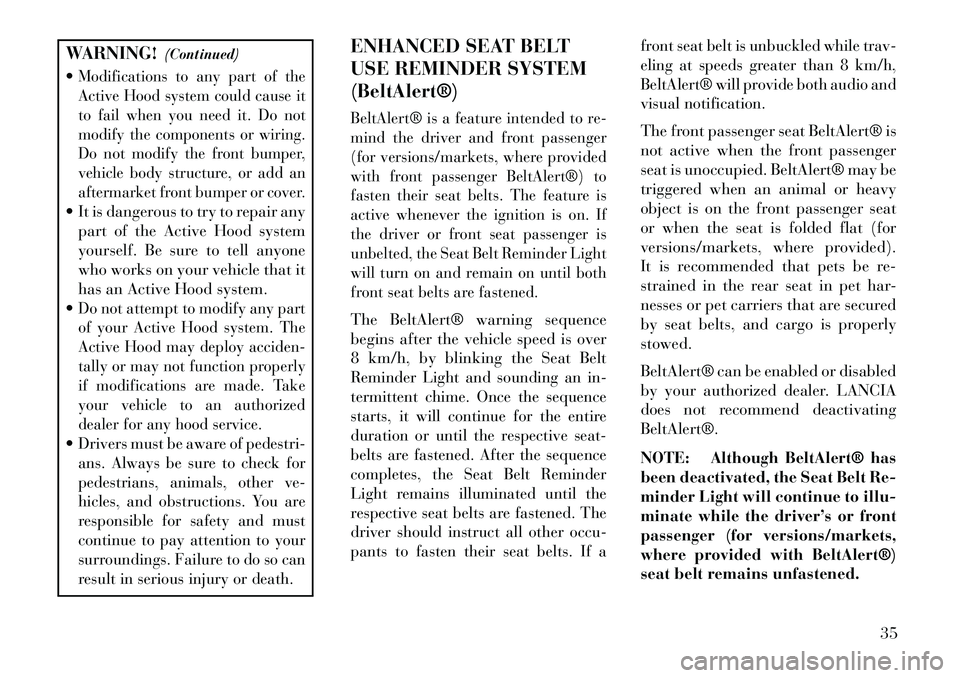
WARNING!(Continued)
Modifications to any part of the
Active Hood system could cause it
to fail when you need it. Do not
modify the components or wiring.
Do not modify the front bumper,
vehicle body structure, or add an
aftermarket front bumper or cover. It is dangerous to try to repair any part of the Active Hood system
yourself. Be sure to tell anyone
who works on your vehicle that it
has an Active Hood system.
Do not attempt to modify any part
of your Active Hood system. The
Active Hood may deploy acciden-
tally or may not function properly
if modifications are made. Take
your vehicle to an authorized
dealer for any hood service.Drivers must be aware of pedestri-
ans. Always be sure to check for
pedestrians, animals, other ve-
hicles, and obstructions. You are
responsible for safety and must
continue to pay attention to your
surroundings. Failure to do so can
result in serious injury or death.
ENHANCED SEAT BELT
USE REMINDER SYSTEM
(BeltAlert®)BeltAlert® is a feature intended to re-
mind the driver and front passenger
(for versions/markets, where provided
with front passenger BeltAlert®) to
fasten their seat belts. The feature is
active whenever the ignition is on. If
the driver or front seat passenger is
unbelted, the Seat Belt Reminder Light
will turn on and remain on until both
front seat belts are fastened.The BeltAlert® warning sequence
begins after the vehicle speed is over
8 km/h, by blinking the Seat BeltReminder Light and sounding an in-
termittent chime. Once the sequence
starts, it will continue for the entire
duration or until the respective seat-
belts are fastened. After the sequence
completes, the Seat Belt Reminder
Light remains illuminated until the
respective seat belts are fastened. The
driver should instruct all other occu-
pants to fasten their seat belts. If a front seat belt is unbuckled while trav-
eling at speeds greater than 8 km/h,
BeltAlert® will provide both audio and
visual notification.
The front passenger seat BeltAlert® is
not active when the front passenger
seat is unoccupied. BeltAlert® may be
triggered when an animal or heavy
object is on the front passenger seat
or when the seat is folded flat (for
versions/markets, where provided).
It is recommended that pets be re-
strained in the rear seat in pet har-
nesses or pet carriers that are secured
by seat belts, and cargo is properly
stowed.
BeltAlert® can be enabled or disabled
by your authorized dealer. LANCIA
does not recommend deactivating
BeltAlert®.
NOTE: Although BeltAlert® has
been deactivated, the Seat Belt Re-
minder Light will continue to illu-
minate while the driver’s or front
passenger (for versions/markets,
where provided with BeltAlert®)
seat belt remains unfastened.
35
Page 44 of 336

Supplemental Seat-Mounted Side
Air Bags (SAB)Supplemental Seat-Mounted Side Air
Bags (SAB) may provide enhanced pro-
tection to help protect an occupant dur-
ing a side impact. The SAB is marked
with an air bag label sewn into the out-
board side of the front seats.When the air bag deploys, it opens the
seam between the front and side of the
seat's trim cover. Each air bag deploys
independently; a left side impact de-
ploys the left air bag only and a right-
side impact deploys the right air bag
only.NOTE:
Air Bag covers may not be obvious
in the interior trim, but they will
open during air bag deployment. Being too close to the SAB during
deployment could cause you to
be severely injured or killed.
SAB air bags are a supplement to the
seat belt restraint system. Occupants,
including children who are up against
or very close to SAB air bags can be
seriously injured or killed. Occupants,
especially children, should not lean on
or sleep against the door, side win-
dows, or area where the SAB air bags
inflate, even if they are in an infant or
child restraint. Always sit upright as
possible with your back against the
seat back, use the seat belts properly,
and use the appropriate sized child
restraint, infant restraint or booster
seat recommended for the size and
weight of the child. The system includes side impact sen-
sors that are calibrated to deploy the
SAB air bags during impacts that re-
quire air bag occupant protection.
Supplemental Side Air Bag
Inflatable Curtain (SABIC)
SABIC air bags may offer side-impact
protection to front and rear seat out-
board occupants in addition to that
provided by the body structure. Each
air bag features inflated chambers
placed adjacent to the head of each
outboard occupant that reduce the po-
tential for side-impact head injuries.
The SABIC deploy downward, cover-
ing both windows on the impact side.
Supplemental Seat-Mounted Side
Air Bag Label
Supplemental Side Air Bag InflatableCurtains (SABIC) Label Location
38
Page 46 of 336
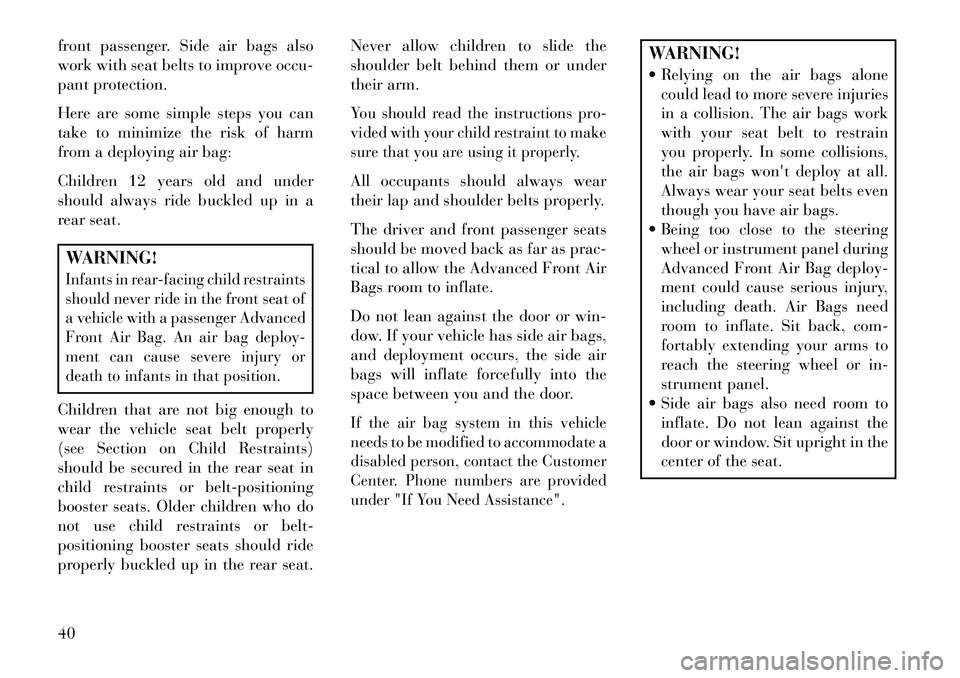
front passenger. Side air bags also
work with seat belts to improve occu-
pant protection.
Here are some simple steps you can
take to minimize the risk of harm
from a deploying air bag:
Children 12 years old and under
should always ride buckled up in a
rear seat.WARNING!Infants in rear-facing child restraints
should never ride in the front seat of
a vehicle with a passenger Advanced
Front Air Bag. An air bag deploy-
ment can cause severe injury or
death to infants in that position.Children that are not big enough to
wear the vehicle seat belt properly
(see Section on Child Restraints)
should be secured in the rear seat in
child restraints or belt-positioning
booster seats. Older children who do
not use child restraints or belt-
positioning booster seats should ride
properly buckled up in the rear seat.Never allow children to slide the
shoulder belt behind them or under
their arm.
You should read the instructions pro-
vided with your child restraint to make
sure that you are using it properly.All occupants should always wear
their lap and shoulder belts properly.
The driver and front passenger seats
should be moved back as far as prac-
tical to allow the Advanced Front Air
Bags room to inflate.
Do not lean against the door or win-
dow. If your vehicle has side air bags,
and deployment occurs, the side air
bags will inflate forcefully into the
space between you and the door.If the air bag system in this vehicle
needs to be modified to accommodate a
disabled person, contact the Customer
Center. Phone numbers are provided
under "If You Need Assistance".
WARNING!
Relying on the air bags alone
could lead to more severe injuries
in a collision. The air bags work
with your seat belt to restrain
you properly. In some collisions,
the air bags won't deploy at all.
Always wear your seat belts even
though you have air bags.
Being too close to the steering wheel or instrument panel during
Advanced Front Air Bag deploy-
ment could cause serious injury,
including death. Air Bags need
room to inflate. Sit back, com-
fortably extending your arms to
reach the steering wheel or in-
strument panel.
Side air bags also need room to inflate. Do not lean against the
door or window. Sit upright in the
center of the seat.
40
Page 57 of 336
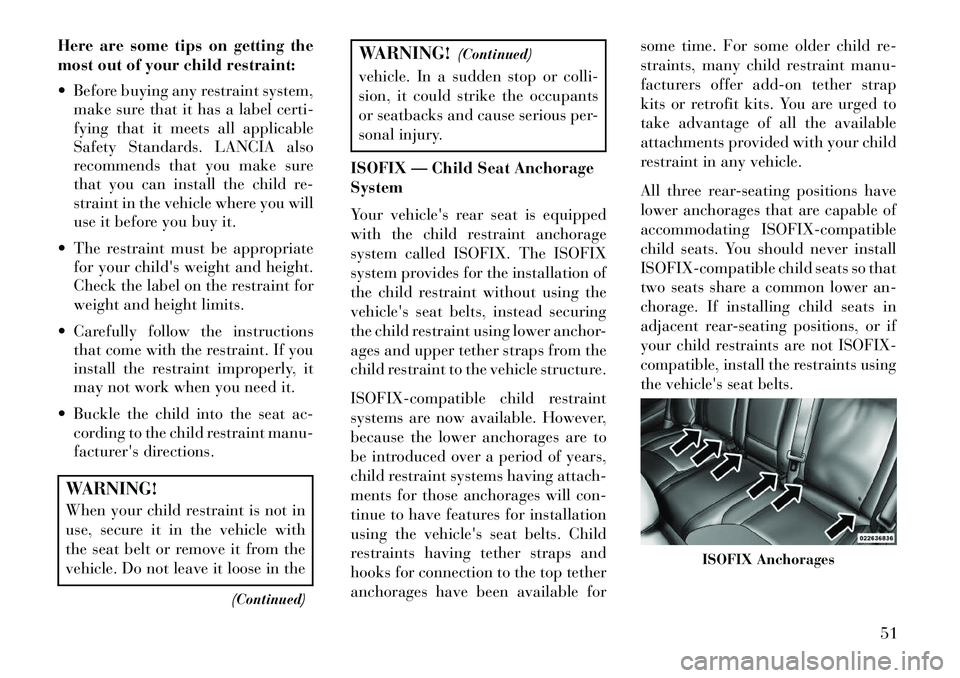
Here are some tips on getting the
most out of your child restraint:
Before buying any restraint system,make sure that it has a label certi-
fying that it meets all applicable
Safety Standards. LANCIA also
recommends that you make sure
that you can install the child re-
straint in the vehicle where you will
use it before you buy it.
The restraint must be appropriate for your child's weight and height.
Check the label on the restraint for
weight and height limits.
Carefully follow the instructions that come with the restraint. If you
install the restraint improperly, it
may not work when you need it.
Buckle the child into the seat ac- cording to the child restraint manu-
facturer's directions.WARNING!
When your child restraint is not in
use, secure it in the vehicle with
the seat belt or remove it from the
vehicle. Do not leave it loose in the
(Continued)
WARNING!(Continued)
vehicle. In a sudden stop or colli-
sion, it could strike the occupants
or seatbacks and cause serious per-
sonal injury.
ISOFIX — Child Seat Anchorage
System
Your vehicle's rear seat is equipped
with the child restraint anchorage
system called ISOFIX. The ISOFIX
system provides for the installation of
the child restraint without using the
vehicle's seat belts, instead securing
the child restraint using lower anchor-
ages and upper tether straps from the
child restraint to the vehicle structure.
ISOFIX-compatible child restraint
systems are now available. However,
because the lower anchorages are to
be introduced over a period of years,
child restraint systems having attach-
ments for those anchorages will con-
tinue to have features for installation
using the vehicle's seat belts. Child
restraints having tether straps and
hooks for connection to the top tether
anchorages have been available for some time. For some older child re-
straints, many child restraint manu-
facturers offer add-on tether strap
kits or retrofit kits. You are urged to
take advantage of all the available
attachments provided with your child
restraint in any vehicle.
All three rear-seating positions have
lower anchorages that are capable of
accommodating ISOFIX-compatible
child seats. You should never install
ISOFIX-compatible child seats so that
two seats share a common lower an-
chorage. If installing child seats in
adjacent rear-seating positions, or if
your child restraints are not ISOFIX-
compatible, install the restraints using
the vehicle's seat belts.
ISOFIX Anchorages
51
Page 59 of 336
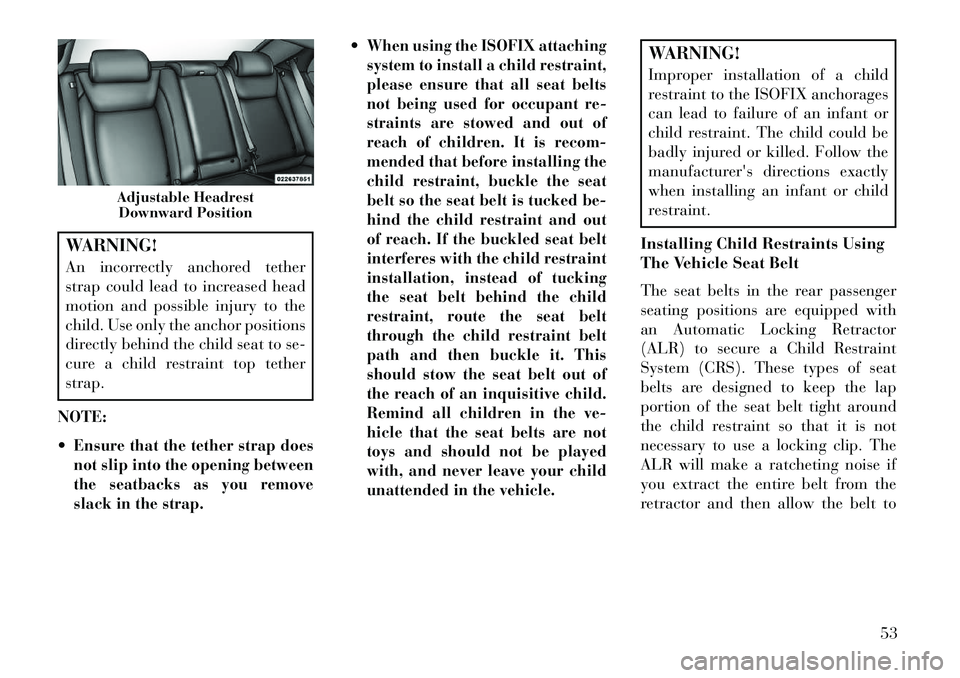
WARNING!
An incorrectly anchored tether
strap could lead to increased head
motion and possible injury to the
child. Use only the anchor positions
directly behind the child seat to se-
cure a child restraint top tether
strap.
NOTE:
Ensure that the tether strap does
not slip into the opening between
the seatbacks as you remove
slack in the strap.
When using the ISOFIX attaching
system to install a child restraint,
please ensure that all seat belts
not being used for occupant re-
straints are stowed and out of
reach of children. It is recom-
mended that before installing the
child restraint, buckle the seat
belt so the seat belt is tucked be-
hind the child restraint and out
of reach. If the buckled seat belt
interferes with the child restraint
installation, instead of tucking
the seat belt behind the child
restraint, route the seat belt
through the child restraint belt
path and then buckle it. This
should stow the seat belt out of
the reach of an inquisitive child.
Remind all children in the ve-
hicle that the seat belts are not
toys and should not be played
with, and never leave your child
unattended in the vehicle.
WARNING!
Improper installation of a child
restraint to the ISOFIX anchorages
can lead to failure of an infant or
child restraint. The child could be
badly injured or killed. Follow the
manufacturer's directions exactly
when installing an infant or child
restraint.
Installing Child Restraints Using
The Vehicle Seat Belt
The seat belts in the rear passenger
seating positions are equipped with
an Automatic Locking Retractor
(ALR) to secure a Child Restraint
System (CRS). These types of seat
belts are designed to keep the lap
portion of the seat belt tight around
the child restraint so that it is not
necessary to use a locking clip. The
ALR will make a ratcheting noise if
you extract the entire belt from the
retractor and then allow the belt to
Adjustable Headrest Downward Position
53
Page 60 of 336

retract into the retractor. For addi-
tional information on ALR, refer to
“Automatic Locking Mode”. The
chart below defines the seating posi-
tions with an Automatic Locking Re-
tractor (ALR) or a cinching latch
plate.
Driver Center Passen-ger
First
Row N/A N/A N/A
Second
Row ALR ALR ALR
N/A — Not ApplicableALR — Automatic Locking RetractorInstalling a Child Restraint with an
ALR:
1. To install a child restraint with
ALR, first, pull enough of the seat belt
webbing from the retractor to route it
through the belt path of the child re-
straint. Slide the latch plate into the
buckle until you hear a “click.” Next,
extract all the seat belt webbing out of
the retractor and then allow the belt to
retract into the retractor. As the belt retracts, you will hear a ratcheting
sound. This indicates the safety belt is
now in the Automatic Locking mode.
2. Finally, pull on any excess web-
bing to tighten the lap portion around
the child restraint. Any seat belt sys-
tem will loosen with time, so check the
belt occasionally, and pull it tight if
necessary.
In the rear center seat, you may
have trouble tightening the lap/
shoulder belt on the child restraint
because the buckle or latch plate is
too close to the belt path opening on
the restraint. Disconnect the latch
plate from the buckle and twist the
short buckle-end belt several times
to shorten it. Insert the latch plate
into the buckle with the release but-
ton facing out.
If the belt still can’t be tightened, or
if pulling and pushing on the re-
straint loosens the belt, disconnect
the latch plate from the buckle, turn
the buckle around, and insert the
latch plate into the buckle again.
If you still can’t make the child re-
straint secure, try a different seating
position.
To attach a child restraint tether strap:1. Rotate the cover over the anchor
directly behind the seat where you are
placing the child restraint.
2. Route the tether strap to provide
the most direct path for the strap be-
tween the anchor and the child seat.
3. Attach the tether strap hook (A) of
the child restraint to the anchor (B)
and remove slack in the tether strap
according to the child restraint manu-
facturer's instructions.
Tether Strap Mounting
1 — Cover A — Tether Strap
Hook
3 — Attaching
Strap B — Tether Anchor
54
Page 61 of 336

NOTE: Ensure that the tether
strap does not slip into the opening
between the seatbacks as you re-
move slack in the strap.WARNING!An incorrectly anchored tether strap
could lead to increased head motion
and possible injury to the child. Use
only the anchor positions directly
behind the child seat to secure a
child restraint top tether strap.Transporting Pets
Air Bags deploying in the front seat
could harm your pet. An unrestrained
pet will be thrown about and possibly
injured, or injure a passenger during
panic braking or in a collision.
Pets should be restrained in the rear
seat in pet harnesses or pet carriers
that are secured by seat belts.ENGINE BREAK-IN
RECOMMENDATIONS
A long break-in period is not required
for the engine and drivetrain (trans-
mission and axle) in your vehicle.
Drive moderately during the first
500 km. After the initial 100 km, speeds
up to 80 or 90 km/h are desirable.While cruising, brief full-throttle ac-
celeration within the limits of local
traffic laws contributes to a good
break-in. Wide-open throttle accel-
eration in low gear can be detrimental
and should be avoided.The engine oil installed in the engine at
the factory is a high-quality energy
conserving type lubricant. Oil changes
should be consistent with anticipated
climate conditions under which vehicle
operations will occur. For the recom-
mended viscosity and quality grades, refer to “Maintenance Procedures” in
“Maintaining Your Vehicle”. NON-
DETERGENT OR STRAIGHT MIN-
ERAL OILS MUST NEVER BE USED.
A new engine may consume some oil
during its first few thousand kilo-
meters of operation. This should be
considered a normal part of the
break-in and not interpreted as an
indication of difficulty.
Additional Requirements
For Diesel Engine
During the first 1500 km avoid heavy
loads, e.g. driving at full throttle.
Do not exceed 2/3 of the maximum
permissible engine speed for each
gear. Change gear in good time. Do
not shift down a gear manually in
order to brake.
55
Page 63 of 336

Safety Checks You Should
Make Inside The Vehicle
Seat BeltsInspect the belt system periodically,
checking for cuts, frays, and loose
parts. Damaged parts must be replaced
immediately. Do not disassemble or
modify the system.
Front seat belt assemblies must be re-
placed after a collision. Rear seat belt
assemblies must be replaced after a
collision if they have been damaged
(i.e., bent retractor, torn webbing,
etc.). If there is any question regarding
belt or retractor condition, replace the
belt.Air Bag Warning Light
The light should come on
and remain on for four to
eight seconds as a bulb
check when the ignition
switch is first turned ON. If the light
is not lit during starting, see your
authorized dealer. If the light stays on,
flickers, or comes on while driving,
have the system checked by an autho-
rized dealer.
Defroster
Check operation by selecting the de-
frost mode and place the blower con-
trol on high speed. You should be able
to feel the air directed against the
windshield. See your authorized
dealer for service if your defroster is
inoperable.
Floor Mat Safety Information
Always use floor mats designed to fit
the footwell of your vehicle. Use only
floor mats that leave the pedal area
unobstructed and that are firmly se-
cured so that they cannot slip out of
position and interfere with the pedals
or impair safe operation of your ve-
hicle in other ways.WARNING!
Pedals that cannot move freely can
cause loss of vehicle control and
increase the risk of serious personal
injury.
Always make sure that floor mats
are properly attached to the floor
mat fasteners.
(Continued)
WARNING!(Continued)
Never place or install floor mats or other floor coverings in the
vehicle that cannot be properly
secured to prevent them from
moving and interfering with the
pedals or the ability to control the
vehicle.
Never put floor mats or other floor
coverings on top of already in-
stalled floor mats. Additional floor
mats and other coverings will re-
duce the size of the pedal area and
interfere with the pedals. Check mounting of mats on a regular basis. Always properly re-
install and secure floor mats that
have been removed for cleaning.
Always make sure that objects cannot fall into the driver foot-
well while the vehicle is moving.
Objects can become trapped un-
der the brake pedal and accelera-
tor pedal causing a loss of vehicle
control.
(Continued)
57
Page 98 of 336
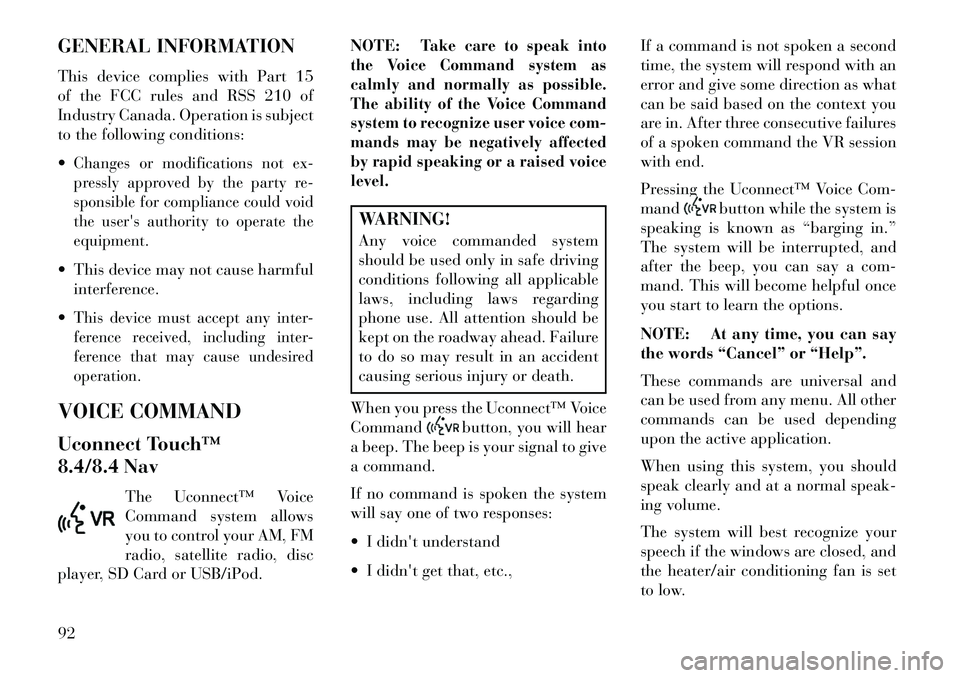
GENERAL INFORMATION
This device complies with Part 15
of the FCC rules and RSS 210 of
Industry Canada. Operation is subject
to the following conditions:
Changes or modifications not ex-
pressly approved by the party re-
sponsible for compliance could void
the user's authority to operate the
equipment. This device may not cause harmfulinterference.
This device must accept any inter-
ference received, including inter-
ference that may cause undesired
operation.VOICE COMMAND
Uconnect Touch™
8.4/8.4 Nav The Uconnect™ Voice
Command system allows
you to control your AM, FM
radio, satellite radio, disc
player, SD Card or USB/iPod. NOTE:
Take care to speak into
the Voice Command system as
calmly and normally as possible.
The ability of the Voice Command
system to recognize user voice com-
mands may be negatively affected
by rapid speaking or a raised voice
level.
WARNING!
Any voice commanded system
should be used only in safe driving
conditions following all applicable
laws, including laws regarding
phone use. All attention should be
kept on the roadway ahead. Failure
to do so may result in an accident
causing serious injury or death.
When you press the Uconnect™ Voice
Command
button, you will hear
a beep. The beep is your signal to give
a command.
If no command is spoken the system
will say one of two responses:
I didn't understand
I didn't get that, etc., If a command is not spoken a second
time, the system will respond with an
error and give some direction as what
can be said based on the context you
are in. After three consecutive failures
of a spoken command the VR session
with end.
Pressing the Uconnect™ Voice Com-
mand
button while the system is
speaking is known as “barging in.”
The system will be interrupted, and
after the beep, you can say a com-
mand. This will become helpful once
you start to learn the options.
NOTE: At any time, you can say
the words “Cancel” or “Help”.
These commands are universal and
can be used from any menu. All other
commands can be used depending
upon the active application.
When using this system, you should
speak clearly and at a normal speak-
ing volume.
The system will best recognize your
speech if the windows are closed, and
the heater/air conditioning fan is set
to low.
92